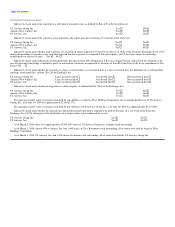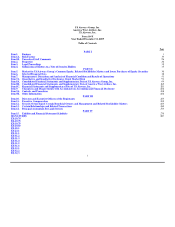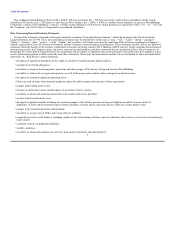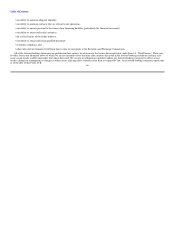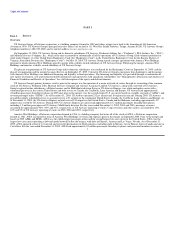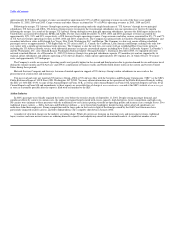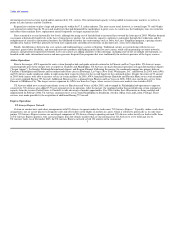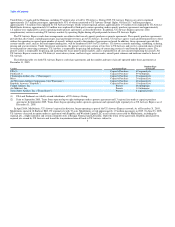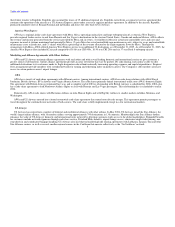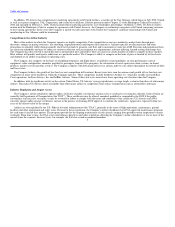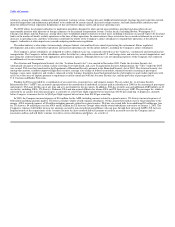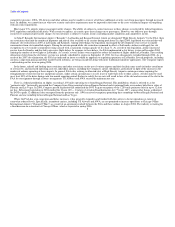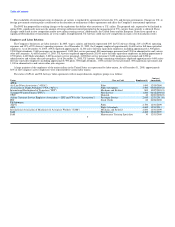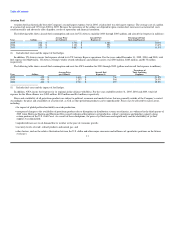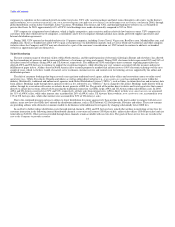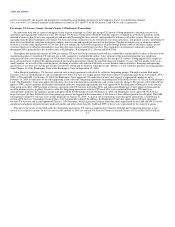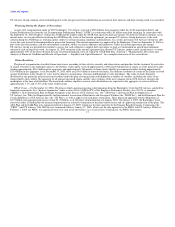US Airways 2005 Annual Report Download - page 13
Download and view the complete annual report
Please find page 13 of the 2005 US Airways annual report below. You can navigate through the pages in the report by either clicking on the pages listed below, or by using the keyword search tool below to find specific information within the annual report.
Table of Contents
relating to, among other things, enhanced ground proximity warning systems, fuselage pressure bulkhead reinforcement, fuselage lap joint inspection rework,
increased inspections and maintenance procedures to be conducted on certain aircraft, increased cockpit security, fuel tank flammability reductions and
domestic reduced vertical separation. Regulations of this sort tend to enhance safety and increase operating costs.
The DOT allows local airport authorities to implement procedures designed to abate special noise problems, provided such procedures do not
unreasonably interfere with interstate or foreign commerce or the national transportation system. Certain locales, including Boston, Washington, D.C.,
Chicago, San Diego and San Francisco, among others, have established airport restrictions to limit noise, including restrictions on aircraft types to be used and
limits on the number of hourly or daily operations or the time of these operations. In some instances these restrictions have caused curtailments in services or
increases in operating costs, and these restrictions could limit the ability of the Company's airline subsidiaries to expand their operations at the affected
airports. Authorities at other airports may consider adopting similar noise regulations.
The airline industry is also subject to increasingly stringent federal, state and local laws aimed at protecting the environment. Future regulatory
developments and actions could affect operations and increase operating costs for the airline industry, including the Company's airline subsidiaries.
The Company's airline subsidiaries are obligated to collect a federal excise tax, commonly referred to as the "ticket tax," on domestic and international air
transportation. The Company's airline subsidiaries collect the ticket tax, along with certain other U.S. and foreign taxes and user fees on air transportation, and
pass along the collected amounts to the appropriate governmental agencies. Although these taxes are not operating expenses of the Company, they represent
an additional cost to our customers.
The Aviation and Transportation Security Act (the "Aviation Security Act") was enacted in November 2001. Under the Aviation Security Act,
substantially all aspects of civil aviation security screening were federalized, and a new Transportation Security Administration (the "TSA") under the DOT
was created. TSA was then transferred to the Department of Homeland Security pursuant to the Homeland Security Act of 2002. The Aviation Security Act,
among other matters, mandates improved flight deck security; carriage at no charge of federal air marshals; enhanced security screening of passengers,
baggage, cargo, mail, employees and vendors; enhanced security training; fingerprint-based background checks of all employees and vendor employees with
access to secure areas of airports pursuant to regulations issued in connection with the Aviation Security Act; and the provision of passenger data to
U.S. Customs and Border Protection.
Funding for TSA is provided by a combination of air-carrier fees, passenger fees, and taxpayer monies. The air-carrier fee, or Aviation Security
Infrastructure Fee ("ASIF") has an annual cap equivalent to the amount that an individual air carrier paid in calendar year 2000 for the screening of passengers
and property. TSA may lift this cap at any time and set a new higher fee for air carriers. In addition, TSA has recently assessed additional ASIF liability on 43
air carriers, including AWA, US Airways, Piedmont, PSA and non-owned affiliates for whom AWA and US Airways pay ASIF. The passenger fee, which is
collected by air carriers from their passengers, is currently set at $2.50 per flight segment but not more than $10.00 per round trip. A proposal is currently
before Congress to increase the fee to $5.00 per flight segment but not more than $10.00 per round trip.
In 2005, the Company incurred expenses of $16 million for the ASIF, including amounts related to regional carriers. US Airways incurred expenses of
$28 million including amounts paid by US Airways Group's wholly owned regional subsidiaries. Of this amount $21 million was for the period prior to the
merger. AWA incurred expenses of $9 million including amounts related to regional carriers. TSA has also issued bills for an additional $9 million per year
for US Airways, $4 million per year for AWA and $2 million for US Airways Group's other wholly owned subsidiaries retroactive to January 1, 2005. The
Company's expenses will further increase for amounts assessed to non-owned regional affiliates who can pass through their increased ASIF to US Airways.
Implementation of the requirements of the Aviation Security Act have resulted and will continue to result in increased costs for the Company and its
passengers and has and will likely continue to result in service disruptions and delays. As a result of
7


